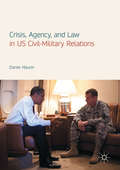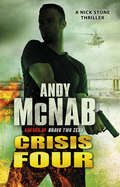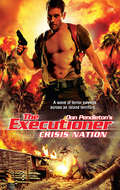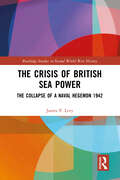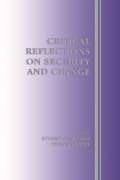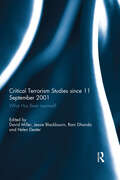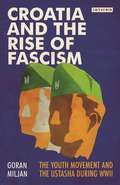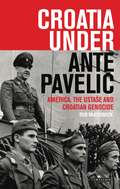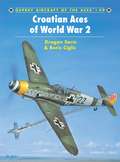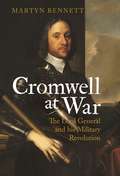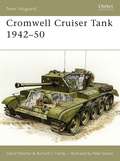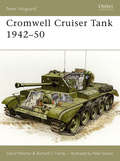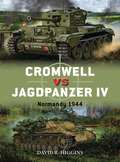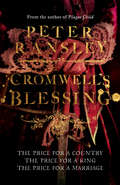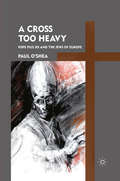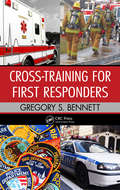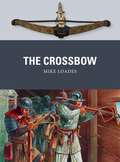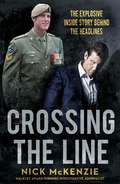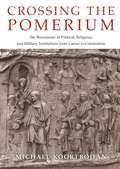- Table View
- List View
Crisis, Agency, and Law in US Civil-Military Relations
by Daniel MaurerThis book develops a responsible and practical method for evaluating the success, failure, or “crisis” of American civil-military relations among its political and uniformed elite. The author’s premise is that currently there is no objectively fair way for the public at large or the strategic-level elites to assess whether the critical and often obscured relationships between Generals, Admirals, and Statesmen function as they ought to under the US constitutional system. By treating these relationships—in form and practice—as part of a wider principal (civilian)-agency (military) dynamic, the book tracks the “duties”—care, competence, diligence, confidentiality, scope of responsibility—and perceived shortcomings in the interactions between US civilian political authorities and their military advisors in both peacetime and in war.
Crisis and Resilience in the Bristol-West India Sugar Trade, 1783-1802 (Eighteenth-Century Worlds #13)
by Peter BucklesHow did merchants deal with crises? From warfare to financial upheaval, from political machinations to the abolition of the slave trade, merchants and their networks in the eighteenth century faced a range of challenges. But they also demonstrated remarkable resilience. Providing new levels of detail on Britain’s sugar trade, this authoritative account explores how Bristol’s sugar merchants embodied cogs in the plantation machine, using their position of influence in Britain to maintain the production of sugar and violent systems of enslavement. It demonstrates how, as shipowners, these merchants protected their shipping, led the organisation of convoys, and took advantage of cheapening insurance. It reveals the inner workings of the sugar market and the strategies merchants used to remain profitable, showing how merchants navigated the transitions between peace and war. Finally, it uncovers their methods for managing credit and safeguarding their investments. Throughout, the nature of commerce in the eighteenth century is analysed in detail, from business networks to bills of exchange. Demonstrating meticulous, interdisciplinary research and thorough analysis of merchant business records, this book speaks broadly to the nature and experience of crisis in the eighteenth century and what this meant for the burgeoning systems of capitalism.
Crisis Four: (Nick Stone Thriller 2) (Nick Stone #2)
by Andy McNabThe bestselling Nick Stone thriller - a heart-stopping novel of violence, betrayal and high-octane suspense.Ex-SAS trooper Nick Stone is extremely highly trained. Clever, ruthless and very effective, it is no surprise that he is hired by British Intelligence. On deniable operations - one of the most dangerous lines of work. Sarah Greenwood is beautiful, intelligent and cunning - and the only woman Stone has ever truly opened up to. But now he has been ordered to hunt her down.Hotly pursued through the American wilderness, Stone finds himself at the centre of a deadly game of cat and mouse. He must get to the heart of a terrifying conspiracy theory to which only Sarah holds the key. But will he manage to before the tension reaches boiling point?'A rollercoaster ride' Guardian
Crisis Nation
by Don PendletonWhen American military personnel are found beheaded in the swamps of Puerto Rico, Mack Bolan boards a plane and lands in a political revolution. As the streets of San Juan turn bloody, he suspects someone outside the country is running the show and the gangs behind the military slaughter are simple pawns in a much more complex game.
The Crisis of British Sea Power: The Collapse of a Naval Hegemon 1942 (Routledge Studies in Second World War History)
by James LevyThis work is a close examination of the conditions surrounding and precipitating the last gasp of British naval hegemony and events that led to its demise. Great Britain undertook a massive naval building program in the late-1930s in order to deter aggression and secure dominance at sea against her nascent enemies, Nazi Germany and Fascist Italy. But the failure of the policy of Appeasement to deter war or delay it into the early 1940s left the building program only partially complete, and the exigencies of war led to the cancellation of the critical but costly and time-consuming “Lion” class battleships, and the slow delivery of the “1940 battlecruiser” (HMS Vanguard) and two vital fleet carriers. Adding to these issues, the fall of France spurred the USA to initiate her own, even larger, naval building program, and together with the entry of the powerful and capable Imperial Japanese Navy completely overwhelmed Britain’s position as the world’s premier naval power. This book will be of value to those interested in the history of the Second World War, British strategy, and the British navy.
The Crisis of British Sea Power: The Collapse of a Naval Hegemon 1942 (Routledge Studies in Second World War History)
by James LevyThis work is a close examination of the conditions surrounding and precipitating the last gasp of British naval hegemony and events that led to its demise. Great Britain undertook a massive naval building program in the late-1930s in order to deter aggression and secure dominance at sea against her nascent enemies, Nazi Germany and Fascist Italy. But the failure of the policy of Appeasement to deter war or delay it into the early 1940s left the building program only partially complete, and the exigencies of war led to the cancellation of the critical but costly and time-consuming “Lion” class battleships, and the slow delivery of the “1940 battlecruiser” (HMS Vanguard) and two vital fleet carriers. Adding to these issues, the fall of France spurred the USA to initiate her own, even larger, naval building program, and together with the entry of the powerful and capable Imperial Japanese Navy completely overwhelmed Britain’s position as the world’s premier naval power. This book will be of value to those interested in the history of the Second World War, British strategy, and the British navy.
Critical Reflections on Security and Change
by Stuart Croft Terry TerriffThe contributors reflect critically on security studies since the 1980s. They conclude that analysts and policy-makers have not been able to respond well to the changes that have occurred and that they must revise their approach if they are to meet the challenges of the future.
Critical Reflections on Security and Change
by Stuart Croft Terriff TerryThe contributors reflect critically on security studies since the 1980s. They conclude that analysts and policy-makers have not been able to respond well to the changes that have occurred and that they must revise their approach if they are to meet the challenges of the future.
Critical Terrorism Studies since 11 September 2001: What Has Been Learned?
by David Miller Jessie Blackbourn Helen Dexter Rani DhandaAcademic studies of ‘terrorism’ grew exponentially in number after the September 11 attacks. The problem was that much of this work of ‘orthodox’ terrorism studies was biased, often shoddily researched and was too closely identified with the power centres of Western states. Its denizens were often former and sometimes current officials or officers in the military, intelligence services or the security industry or were funded by them.In response the project of Critical Terrorism Studies was intended to give a more rounded account of political violence in the world. It focuses on neglected issues like state terrorism, Western counterinsurgency, propaganda and misinformation.More than a decade since the founding of the critical project, this book asks what has been learned. It showcases leading examples of critical terrorism studies and presents an agenda for the expansion of an evidence-based approach to political violence and terrorism. With chapters by leading authorities such as Joseba Zulaika, Michael Stohl, Mary Hickman and Richard Jackson, the book evaluates how far the critical project has come and where it is going next.This book was published as a special issue of Critical Studies on Terrorism.
Critical Terrorism Studies since 11 September 2001: What Has Been Learned?
by David Miller Jessie Blackbourn Rani Dhanda Helen DexterAcademic studies of ‘terrorism’ grew exponentially in number after the September 11 attacks. The problem was that much of this work of ‘orthodox’ terrorism studies was biased, often shoddily researched and was too closely identified with the power centres of Western states. Its denizens were often former and sometimes current officials or officers in the military, intelligence services or the security industry or were funded by them.In response the project of Critical Terrorism Studies was intended to give a more rounded account of political violence in the world. It focuses on neglected issues like state terrorism, Western counterinsurgency, propaganda and misinformation.More than a decade since the founding of the critical project, this book asks what has been learned. It showcases leading examples of critical terrorism studies and presents an agenda for the expansion of an evidence-based approach to political violence and terrorism. With chapters by leading authorities such as Joseba Zulaika, Michael Stohl, Mary Hickman and Richard Jackson, the book evaluates how far the critical project has come and where it is going next.This book was published as a special issue of Critical Studies on Terrorism.
Croatia and the Rise of Fascism: The Youth Movement and the Ustasha During WWII (Library Of World War Two Studies #2)
by Goran MiljanDuring World War II, Croatia became a fascist state under the control of the Ustasha Movement - allied with Nazi Germany and Fascist Italy. Here, Goran Miljan examines and analyzes for the first time the ideology, practices, and international connections of the Ustasha Youth organization. The Ustasha Youth was an all-embracing fascist youth organization, established in July 1941 by the `Independent State of Croatia' with the goal of reeducating young people in the model of an ideal `new' Croat. This youth organization attempted to set in motion an all-embracing, totalitarian national revolution which in reality consisted of specific interconnected, mutually dependent practices: prosecution, oppression, mass murder, and the Holocaust - all of which were officially legalized within a month of the regime's accession to power. To this end education, sport, manual work and camping took place in specially established Ustasha Youth Schools. In order to justify their radical policies of youth reeducation, the Ustasha Youth, besides emphasizing national character and the importance of cultural and national purity, also engaged in transnational activities and exchanges, especially with the Hlinkova mladez [Hlinka Youth] of the Slovak Republic. Both youth organizations were closely modelled after the youth organizations in Nazi Germany and Fascist Italy. This is a little studied part of the history of World War II and of Fascism, and will be essential reading for scholars of Central Europe and the Holocaust.
Croatia Under Ante Pavelic: America, the Ustase and Croatian Genocide in World War II (International Library of Twentieth Century History)
by Robert B. McCormickAnte Pavelic was the leader of the fascist party of Croatia (the Ustaše), who, on Adolf Hitler's instruction, became the leader of Croatia after the Nazi invasion of 1941. Paveli? was an extreme Croatian nationalist who believed that the Serbian people were an inferior race - he would preside over a genocide that ultimately killed an estimated 390,000 Serbs during World War II. Croatia under Ante Paveli? provides the full history of this period, with a special focus on the United States' role in the post-war settlement. Drawing on previously unpublished documents, Robert McCormick argues that President Harry S. Truman's Cold War priorities meant that Paveli? was never made to answer for his crimes. Today, the Ustaše remains difficult legacy within Croatian society, partly as a result of Paveli?' political life in exile in South America. This is a new account of US foreign policy towards one of the Second World War's most brutal dictators and is an essential contribution to Croatian war-time history.
Croatian Aces of World War 2 (Aircraft of the Aces)
by John Weal Boris Ciglic Dragan SavicInitially flying Italian-supplied Fiat G.50s, the Croat forces suffered heavy losses during 1942 whilst flying alongside JG 52 in the southern sector of the Russian front. Despite this, a significant number of kills fell to future aces such as Cvitan Galic and Mato Dubovak during this time, and when the units re-equipped with Bf 109G-10s in 1943, battle-seasoned Croat pilots started to rack up impressive scores. This book reveals how, by 1944, Croat air groups were defending Yugoslavia from British and American air raids, and in the final months of the war a handful of surviving pilots fought on until final defeat in May 1945.
Croatian Aces of World War 2 (Aircraft of the Aces #49)
by John Weal Boris Ciglic Dragan SavicInitially flying Italian-supplied Fiat G.50s, the Croat forces suffered heavy losses during 1942 whilst flying alongside JG 52 in the southern sector of the Russian front. Despite this, a significant number of kills fell to future aces such as Cvitan Galic and Mato Dubovak during this time, and when the units re-equipped with Bf 109G-10s in 1943, battle-seasoned Croat pilots started to rack up impressive scores. This book reveals how, by 1944, Croat air groups were defending Yugoslavia from British and American air raids, and in the final months of the war a handful of surviving pilots fought on until final defeat in May 1945.
Cromwell at War: The Lord General and his Military Revolution
by Martyn BennettOliver Cromwell was arguably the most significant political figure in the early modern history of the British Isles. Yet he was also a military leader, with significant battlefield victories to his credit. Martyn Bennett here provides the first military biography of Cromwell in the context of the seventeenth century Military Revolution. After commanding a small troop in 1643 and, without prior military experience, Cromwell rose to lead the cavalry regiments of the Eastern Association Army and the New Model Army to final victory at Worcester in 1651 and sealed the victory of the Parliamentary forces in Ireland and Scotland, becoming Lord General in 1650. Martyn Bennett analyses Cromwell's military talents and generalship, in addition to his well-attested powerful and even brutal discipline and religious fervour. He examines the controversial Irish campaigns as well as modern accusations of genocide. In providing new perspectives on Cromwell's military career, Bennett adds to our understanding of England's only non-royal head of state.
Cromwell Cruiser Tank 1942–50 (New Vanguard)
by Peter Sarson David Fletcher Richard C HarleyFor most of World War II, British tank development remained faithful to the design philosophy inaugurated during World War I. Experiences in North Africa highlighted flaws in this basic design, however, and the General Staff identified the need for a new heavy cruiser that could combine speed and manoeuvrability with increased armour and armament. The Cromwell Cruiser tank was designed as a result and soon proved itself one of the fastest and most successful tanks deployed by the Allies during World War II. This book details the design and development of the Cromwell and its many variants, from its introduction at D-Day, through its many successes in the final year of World War II and beyond.
Cromwell Cruiser Tank 1942–50 (New Vanguard #104)
by Peter Sarson David Fletcher Richard C HarleyFor most of World War II, British tank development remained faithful to the design philosophy inaugurated during World War I. Experiences in North Africa highlighted flaws in this basic design, however, and the General Staff identified the need for a new heavy cruiser that could combine speed and manoeuvrability with increased armour and armament. The Cromwell Cruiser tank was designed as a result and soon proved itself one of the fastest and most successful tanks deployed by the Allies during World War II. This book details the design and development of the Cromwell and its many variants, from its introduction at D-Day, through its many successes in the final year of World War II and beyond.
Cromwell vs Jagdpanzer IV: Normandy 1944 (Duel #86)
by Johnny Shumate David R. Higgins Alan GillilandBy 1944, the evolution of armoured doctrine had produced very different outcomes in Britain and Germany. Offering a good balance of speed, protection and firepower, the British Cromwell tank was much faster than its German opponent, but the Jagdpanzer IV tank destroyer had a high-velocity main gun and a lower profile that made it formidable on the defensive, especially in ambush situations. The two types would fight in a series of bloody encounters, from the initial days of the struggle for Normandy through to its climax as the Allies sought to trap their opponents in the Falaise Pocket. Using archive photographs, specially commissioned artwork and battle reports, this fascinating study expertly assesses the realities of tactical armoured combat during the desperate battles after D-Day.
Cromwell vs Jagdpanzer IV: Normandy 1944 (Duel #86)
by Johnny Shumate David R. Higgins Alan GillilandBy 1944, the evolution of armoured doctrine had produced very different outcomes in Britain and Germany. Offering a good balance of speed, protection and firepower, the British Cromwell tank was much faster than its German opponent, but the Jagdpanzer IV tank destroyer had a high-velocity main gun and a lower profile that made it formidable on the defensive, especially in ambush situations. The two types would fight in a series of bloody encounters, from the initial days of the struggle for Normandy through to its climax as the Allies sought to trap their opponents in the Falaise Pocket. Using archive photographs, specially commissioned artwork and battle reports, this fascinating study expertly assesses the realities of tactical armoured combat during the desperate battles after D-Day.
Cromwell’s Blessing
by Peter RansleyThe price for a country. The price for a King. The price for a marriage. The dramatic story of Tom Neave continues…
A Cross Too Heavy: Pope Pius XII and the Jews of Europe
by P. O'SheaThe papacy of Pius XII (1939-1958) has been a source of near-constant criticism and debate since his death, particularly because of his alleged silence during the Holocaust. Paul O'Shea examines his little-studied pre-papal life to demonstrate that Pius was neither an anti-Semitic villain nor a 'lamb without stain.'
Cross-Training for First Responders
by Gregory BennettThe tragedy that occurred in the United States on September 11, 2001 brought enhanced emergency preparedness among first responders to the forefront of public awareness. Since those events � and despite significant progress made in many of the areas previously deemed deficient � some response areas are still woefully inadequate. Cross-Training for
The Crossbow (Weapon #61)
by Peter Dennis Mike LoadesTechnologically sophisticated and powerful, the crossbow has long enjoyed a popular reputation for villainous superiority because it could be used with little training as a weapon of assassination. The study of bow designs, trigger mechanisms and spanning devices reveals a tale of considerable mechanical ingenuity; advances that produced a battlefield weapon requiring comparatively little training to use. It was an extremely useful weapon, and especially effective in siege warfare for both attack and defence.Known to the Ancient Greeks and the Chinese as early as the 5th century BC, the crossbow developed both in Western Europe and in the Far East. Advances in trigger mechanisms, spanning and bow design allowed the development of ever more powerful bows. In this study acknowledged weaponry expert Mike Loades traces the origins, development, combat record and lasting legacy of the crossbow, the formidable projectile weapon that played a key role in a host of battles and sieges across Europe and Asia.
Crossing the Line
by Nick McKenzie'There is no doubt the truth would have been concealed and our concerns buried without Nick McKenzie's relentless pursuit of justice.' SAS Afghanistan veteranWar is brutal. But there are lines that should never be crossed. In mid-2017, whispers of executions, and cover-ups within Australia's most secretive and elite military unit, the SAS, reached Walkley Award-winning journalist Nick McKenzie. He and Chris Masters began an investigation that would not only reveal shocking truths about Ben Roberts-Smith VC but plunge the reporters into the defamation trial of the century.For five years, McKenzie led the investigation, waging an epic battle for the truth to be acknowledged. His fight to reveal the real face of Australia's most famous and revered SAS soldier and examine evidence of bullying, intimidation, war crimes and murder would take him across Australia and to Afghanistan.As he unearthed the secrets Ben Roberts-Smith had thought he'd long ago buried, McKenzie had to deal with death threats, powerful forces intent on destroying his career and attempts to silence brave SAS soldiers, who had witnessed their famous comrade commit unspeakable acts. McKenzie would break the stories that proved the man idolised by the public, politicians, the media and leading business leaders was a myth. His efforts would help deliver justice to Roberts-Smith's victims and their families.Explosive and meticulously researched, Crossing the Line shares the powerful untold story of how a small group of brave soldiers and two determined reporters overcame a plot to suppress one of the greatest military scandals in Australian history.
Crossing the Pomerium: The Boundaries of Political, Religious, and Military Institutions from Caesar to Constantine
by Michael KoortbojianA multifaceted exploration of the interplay between civic and military life in ancient RomeThe ancient Romans famously distinguished between civic life in Rome and military matters outside the city—a division marked by the pomerium, an abstract religious and legal boundary that was central to the myth of the city's foundation. In this book, Michael Koortbojian explores, by means of images and texts, how the Romans used social practices and public monuments to assert their capital's distinction from its growing empire, to delimit the proper realms of religion and law from those of war and conquest, and to establish and disseminate so many fundamental Roman institutions across three centuries of imperial rule.Crossing the Pomerium probes such topics as the appearance in the city of Romans in armor, whether in representation or in life, the role of religious rites on the battlefield, and the military image of Constantine on the arch built in his name. Throughout, the book reveals how, in these instances and others, the ancient ideology of crossing the pomerium reflects the efforts of Romans not only to live up to the ideals they had inherited, but also to reconceive their past and to validate contemporary practices during a time when Rome enjoyed growing dominance in the Mediterranean world.A masterly reassessment of the evolution of ancient Rome and its customs, Crossing the Pomerium explores a problem faced by generations of Romans—how to leave and return to hallowed city ground in the course of building an empire.
